
Phase II of Task 24 takes the theory into practice. Building on the solid theoretical foundations of Phase I, we now look at the:
We use a Collective Impact Approach methodology and storytelling as the overarching language and bring together Behaviour Changers from all sectors (industry, government, research, middle actors and the third sector) with the end users whose behaviour they are ultimately trying to change.
The results from Task 24 (both the theoretical analysis of case studies and in-depth communication and surveys with our many experts) led us to conclude that the reason why energy efficiency is still ‘the greatest market failure of our time’ is because most current approaches are still based on a rather technocratic understanding of energy end user behaviour – with technology, market forces or energy supply dictating interventions geared at behaviour change. We have made a start with presenting this conclusion using storytelling in its many forms. Responses so far were very positive as our stories enabled people (e.g. policymakers) with no background in behavioural sciences to understand how different social science approaches towards behaviour change will have different outcomes.
There are now two things that we need to take a step further:
• We need to elaborate our empiricial knowledge base (elaborate on what, who, why, how?)
• We need to strengthen and support the community of experts into co-creating improved interventions, using storytelling and a collective impact approach as process tools to overcome language barriers, inherent systemic barriers and silos.
We pose that a better understanding of the human aspect of energy use, including behavioural and societal drivers and barriers and external and internal contexts, will greatly improve the uptake of energy efficiency and DSM policies and programmes. This is not at all to say that technology, market and business models and energy supply are not hugely important aspects of the Energy System. Instead, we pose that the Energy System begins and ends with the human need for the services derived from energy (warmth, comfort, entertainment, mobility, hygiene, safety etc) and that behavioural interventions using technology, market and business models and changes to supply and delivery of energy are the all-important means to that end.
We have created a different ‘model of understanding’ (based on work from Task 24 to date) of the energy system and its actors that offers a pragmatic approach for how we propose to further improve the co-creation of knowledge, learning, sharing and translation into practice among practitioners in the energy field.
The way the Energy System is currently established (see Figure 1), does not easily permit such a whole-system view which puts human needs, behaviours and (ir)rationalities at the center of interventions geared at system change.
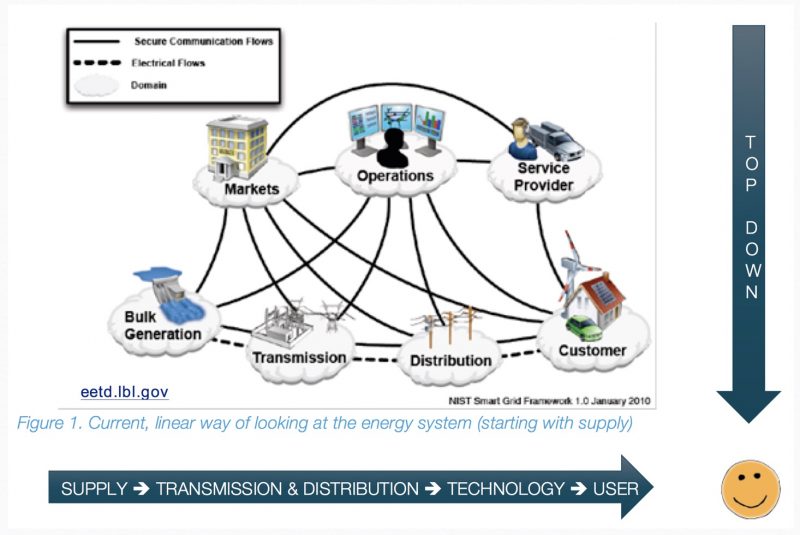
Instead, if we look at the Energy System through the human lens (see video below), we can see that it isn’t necessarily this top-down/left-right linear relationship starting with supply and ending with the end user, but rather a circular relationship which actually starts with the end user need for an energy service (watch below for a short presentation explaining this in more detail).
The Behaviour Changer Framework
In order to visualise the Energy System through the ‘human’, instead of the technocratic lens, we have created a so-called Behaviour Changer Framework (BCF) for Phase II (watch below a short presentation on it).
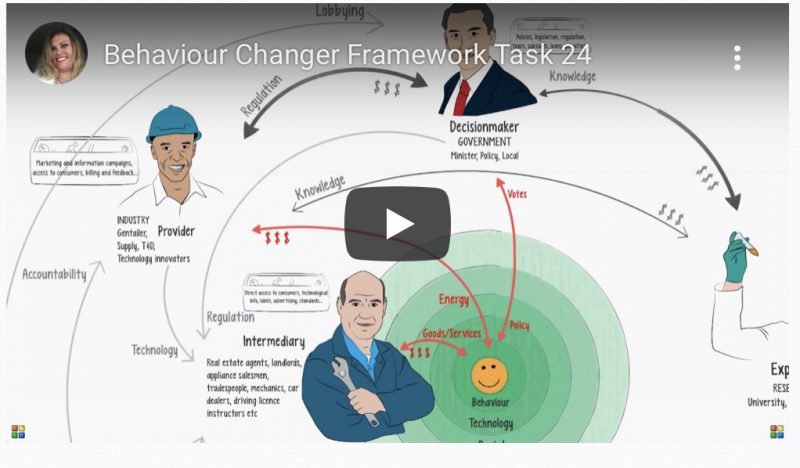 This Framework is meant to achieve several functions:
This Framework is meant to achieve several functions:
The Collective Impact Approach
In addition, we will use a Collective Impact Approach to facilitate the workshops with the different Behaviour Changers, providing the neutral, trusted and respected backbone support necessary to ensure open engagement.
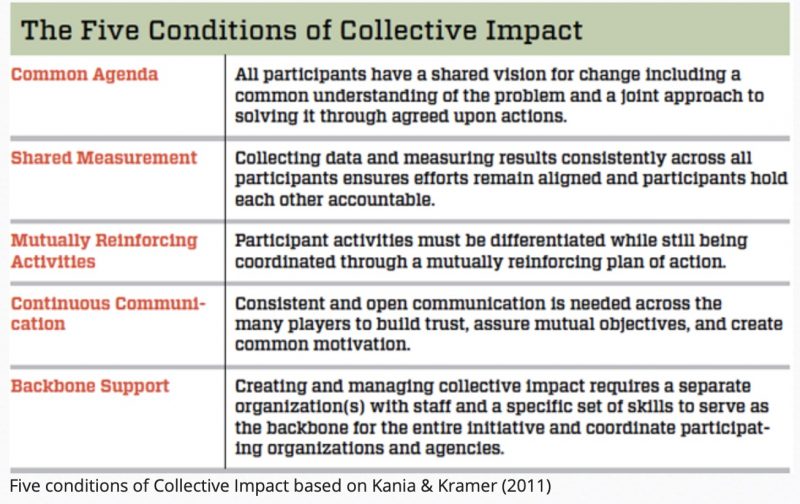
Storytelling will continue to be our overarching language and method of ‘translation’ between different sectors and disciplinary jargon. We will continue to explore the power of storytelling in its many forms, as outlined in our 2015 eceee summer study paper. Task 24 is also co-editing a Special Issue in Energy Research and Social Sciences called ‘Storytelling and narratives in energy and climate change research’. We have received over 50 abstracts from Behaviour Changers all over the world for this publication showing the huge interest on this topic. Task 24 will also be published in this issue, discussing the usefulness of a simple story spine. We have also created an ‘A-Z of storytelling’ report which will be published soon.
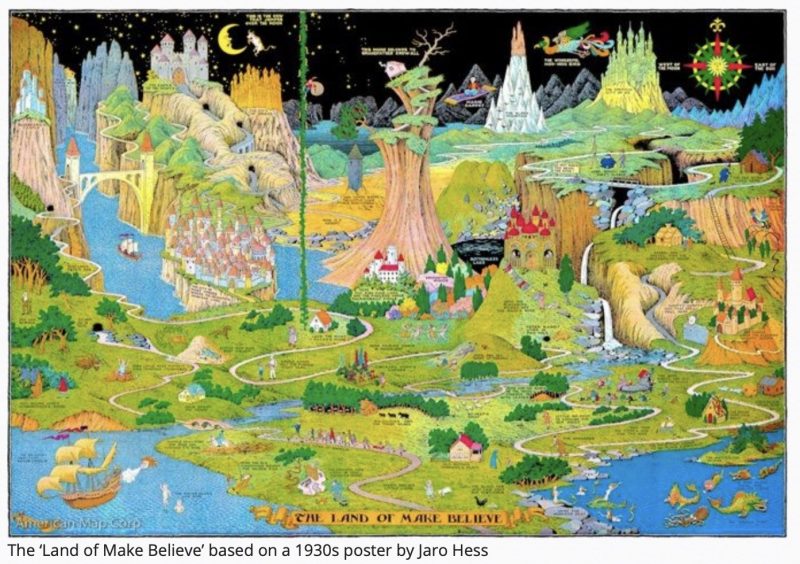
The main objective of this Task is to take good theory into practice to allow Behaviour Changers (from government, industry, intermediaries, research and the third sector) to:
Phase II of Task 24 has very direct benefits to participating (funding) countries and we are still open for interested countries to participate (contact drsea@orcon.net.nz for details). Experts from participating countries will have:
Opportunities for Global Networking and Collaboration
Access to Cutting-Edge Tools and Resources
Co-creation and Promotion of New Solutions to Old Problems
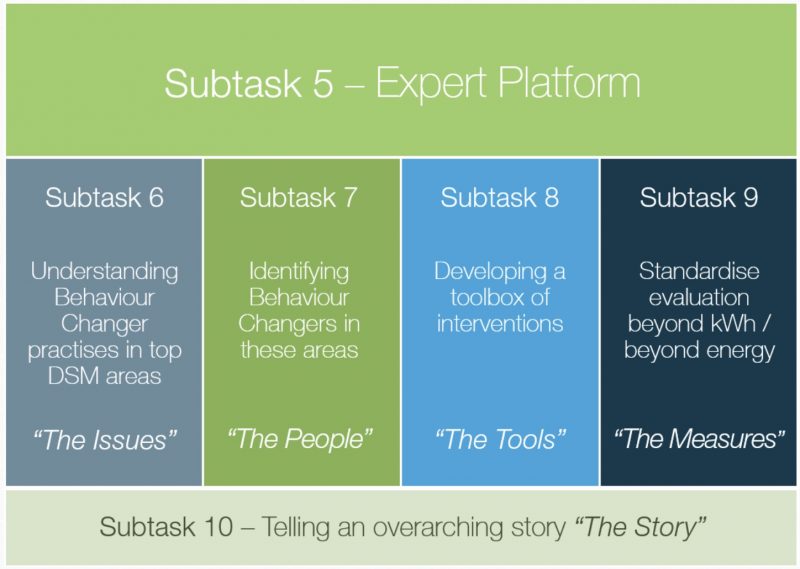
Like Phase I, which followed the logical order of behaviour change intervention phases (Design – Implementation – Evaluation – (Re)Iteration – Dissemination), Phase II also follows a logical order:
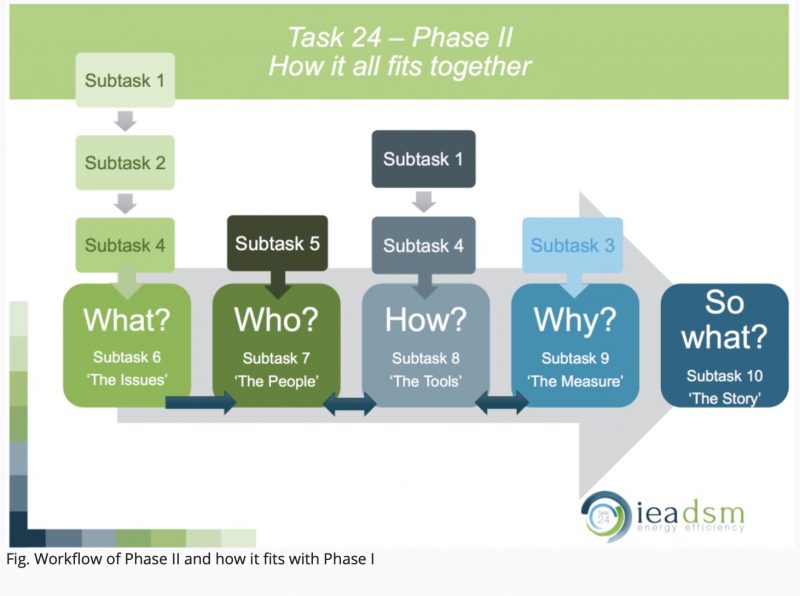
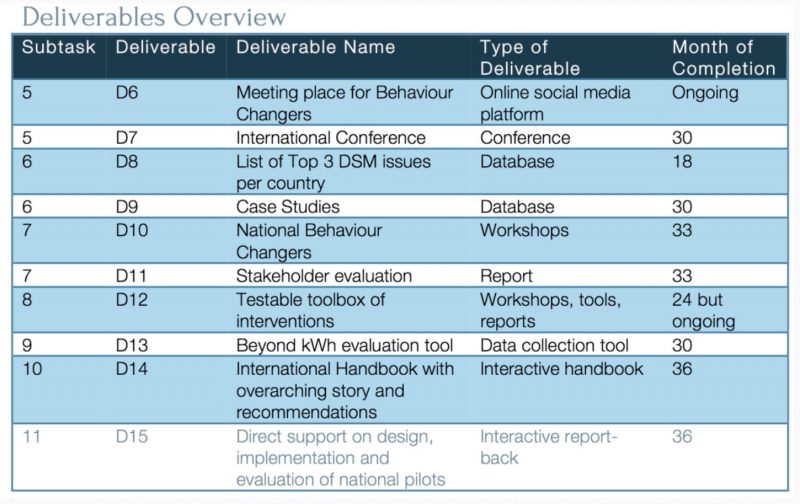
Financially-participating countries:
Austria, Ireland, Netherlands, New Zealand, Sweden, USA
Other Task 24 Contributors (non-state actors):
See Change
Subtask 9 – Beyond kWh tool (Project Partners)
Experts: Drs Beth Karlin, Daniel Chapman, Cindy Frantz and Rebecca Ford
Atrium Health
Subtask 11 – Real-Life Case Studies (co-financed)
Expert: Kady Cowan
ACEEE
Subtask 11 – Real-Life Case Studies (not financed)
Expert: Dr Reuven Sussman
UHN
Subtask 11 – Real-Life Case Studies (not financed)
Expert: Ed Rubinstein
EfficiencyOne
Subtask 11 – Real-Life Case Studies (not financed)
Expert: David Bligh
| Country | Role | Name | |
|---|---|---|---|
| Austria | National Expert | Teresa Kallsperger | kallsperger@grazer-ea.at |
| Ireland | National Expert | Josephine Maguire | josephine.maguire@seai.ie |
| Netherlands | National Expert | Ruth Mourik | ruth.mourik@duneworks.nl |
| New Zealand | National Expert | Sea Rotmann | drsea@orcon.net.nz |
| Sweden | National Expert | Sandra Lennander | sandra.lennander@energimyndigheten.se |
| Sweden | National Expert | Mehmet Bulut | Mehmet.Bulut@energimyndigheten.se |
| Sweden | External Expert | Katy Janda | katy.janda@ouce.ox.ac.uk |
| USA | National Expert | Kira Ashby | kashby@cee1.org |
| Other Task 24 Contributors (non-state actors) | |||
| See Change | Contributor | Bether Karlin Daniel Chapman Cindy Frantz Rebecca Ford | |
| Atrium Health | Contributor | Kady Cowan | |
| American Council for an Energy Efficient Economy (ACEEE) | Contributor | Reuven Sussman | |
| UHN | Contributor | Ed Rubinstein | |
| EfficiencyOne | Contributor | David Bligh |
This is where the Task 24 Phase II publications reside, starting with the most important one: the Work Plan.
A new concept proposal for a “People-Focused Work Stream”: How to ‘do’ behaviour change from A to Z (ExCo only)
Subtask publications (not highlighted are reports for National Expert use only or yet-unpublished reports):
Subtask 6 & 7 – Final Report Austria
Final Report to Funding Agency in Austria [in German]
Subtask 6&7 – Final Report The Netherlands: Executive Summary plus Annexes
Subtask 6&7 – Case Study Analysis – ICT Use in Higher Education – The Netherlands
Subtask 6&7 – Final Report Sweden
Subtask 6&7 -Background for Green Leases in Commercial Office Buildings – Sweden
Subtask 6&7 – Collaboration and Green Leasing: A case study of the Swedish Energy Agency’s new office building in Eskilstuna
Subtask 6&7 – Final Report New Zealand
Subtask 6&7 – Case Study Analysis – Home Energy Audit Tool (HEAT) kits in New Zealand
Subtask 6&7 – Final Report Ireland
Subtask 6&7 – Cross-Country Case Study Comparison Ireland – Home Energy Saving Kit Library Programmes
Subtask 6&7 – Cross-Country Case Study Comparison Ireland – Database of Energy Saving Kit Programmes
Subtask 6&7 – Final Report USA
Subtask 8 – The A to Z of Storytelling in Task 24
Subtask 8 – Template for Focus Groups in Task 24
Subtask 8 – Case Study Templates in Task 24
Subtask 8 – Decision-making Tree for Subtask 1 “Monster” case study analysis
Subtask 8 – Toolbox for Behaviour Changers
Subtask 9 – Dimensions of Energy Behavior: Psychometric Testing of Scales for Evaluating Behavioral Interventions in Demand Side Management Programs
Subtask 9 – Evaluation Report for Home Energy Saving Kits: Using Bayesian Modelling to test the “beyond kWh” toolkit in Ireland
Subtask 10 – Policy Brief Austria
Subtask 10 – Policy Brief the Netherlands
Subtask 10 – Policy Brief Ireland
Subtask 10 – Policy Brief Sweden
Subtask 10 – Policy Brief New Zealand
Subtask 10 – Policy Brief USA
Subtask 10 – The overarching story of Task 24
Subtask 11 – CHS case study: Designing a successful behaviour change programme for hospital building staff
Peer-reviewed publications:
Subtask 9 – B. Karlin, R. Ford and C. McPhearson Frantz (2016), Evaluating Energy Culture: Identifying and validating measures for behaviour-based energy interventions, IEPEC Conference, Amsterdam, Netherlands.
Workshop Minutes:
Subtask 6 and 7 – ECEEE Summer Study Task 24 workshop minutes (2015 and 2017)
Subtask 6 and 7 – BECC conference Task 24 workshop minutes (2015)
Subtask 6 and 7 – BEHAVE conference Task 24 workshop minutes (2016 and 2018)
Articles, blogs, Spotlight etc:
Task 24 – Phase II Flyer
Task 24 Policy Brief
Spotlight September 2015 – Task 24: Helping the Behaviour Changers
Spotlight December 2015: New Publication – Task 24 Subtask 2: The ‘Energy Hunt’ in Austria
Spotlight June 2016 – Task 24 and Annex 66: A beautiful collaboration is emerging
Spotlight March 2017 – Task 24: Creating ‘Magic’ with non-state actors
Spotlight June 2017 – Dr Sea Rotmann: DSM Day in Dublin – Behavioural insights on energy efficiency in the residential sector
Spotlight September 2017 – HOT OF THE PRESS: A new publication on storytelling
University Health Network (UHN) Toronto: Talkin’ Trash with UHN
Energy News – Energy Projects need to center on End Users
Energy in Demand – IEA DSM collaboration programme’s Task 24 Gets Published in Special Issue on ‘Storytelling and Narratives in Energy and Climate Change Research’
eceee News – Special issue of the ERSS journal discusses narratives and storytelling, as a supplement to traditional scientific methods
IEA Expert Group on Research and Development (EGRD), 2018. Towards a consumer-driven energy system.
Spotlight June 2018 – Task 24 insights on Energy Saving Kit Programmes
Spotlight September 2018 – Task 24’s latest participants: the US and Canada via the Consortium for Energy Efficiency
Task 24 – Final Flyer
IEA DSM News Blog
April 26, 2016: Task 24 is co-editing a Special Edition on Storytelling
June 15, 2018: Task 24 releases cross-country case study comparison on Energy Saving Kit Programmes